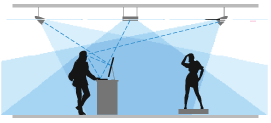
Nobody is a fan of glare, it hurts our eyes and gives us headaches. It is not only uncomfortable but also potentially dangerous as it restricts and distorts visual perception.
In retail environments light should be comfortable so as to not disturb customers, deterring them from entering or lingering in a space, but most importantly it must enable sales personnel and other employees to fulfil their tasks effectively and safely. Glare is caused by the presence of areas within our field of vision that have significantly higher luminance than the background luminance or luminance of the task being undertaken. This causes excessive contrast that ultimately results in reduced visual acuity, Sometimes to an extreme extent.
The quantification of glare is calculated according to the Unified Glare Rating (UGR) system developed by the commission Internationale de I'Eclairage, with lower values representing lower levels of glare. In basic terms, it divides the glare of visible light sources by the general level of background luminance.
UGR=8log [0.25 Σ L2𝜴
L P
Where:
Log = logarithm
L = luminance of light source in the direction of the eye of the observer in cd/m2
Ω = cut off angle of the luminaire relative to the eye of the observer in steradians
P = Guth position index representing the location of the observer relative to the light source
Lb = background illuminance in cd/m2
In retail environment, a general rating of UGR ≤ 22 is recommended in order that customers can comfortable and effectively view the goods on offer.
Whereas at payment counters and packing areas UGR ≤ 19 is recommended, as excessive glare in such places will negatively affect performance and concentration, and cause fatigue and possibly health problems such as eye strain and headaches \. For areas where VDUs are used, which is the case at almost all payment counters, ISO 9241-307 must be followed, which defines the maximum luminance values of the used lighting fixtures at an angle of 65° up to a maximum of 90°.
One special area for consideration is accent lighting as spotlights focus their light very strongly on a small area. To avoid light being directed directly into the eyes of both customers and employees the fixtures must be directed at an angle of no more than 30° from horizontal.
Lighting requirements High Luminance Medium Luminance
Screen Screen
L ≤200cd/m2 L ≤200cd/m2
Case A
For spaces with
Common CRI and ≤ 3000cd/m2 ≤ 1500cd/m2
visual acuity demands.
Case B
For spaces with
Above-standard CRI ≤ 1500cd/m2 ≤ 1000cd/m2
and visual acuity demands

Glare can be both direct, such as when the light from a light source shines directly in the eye, and indirect, such as the reflections from a monitor, table or magazine.Indirect glare in the most harmful as it enters the eye from below, at an angle to which our eye is most sensitive.